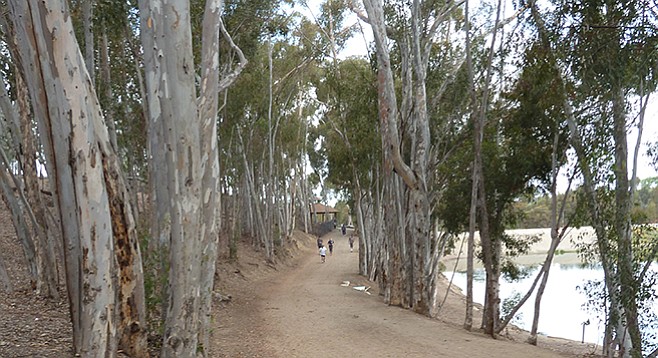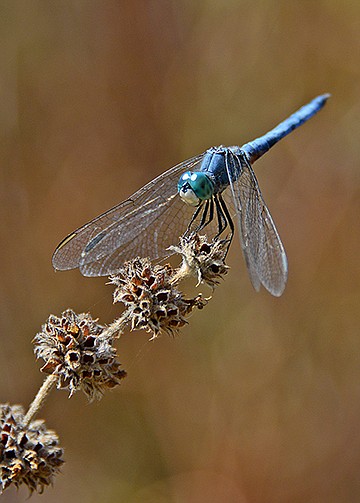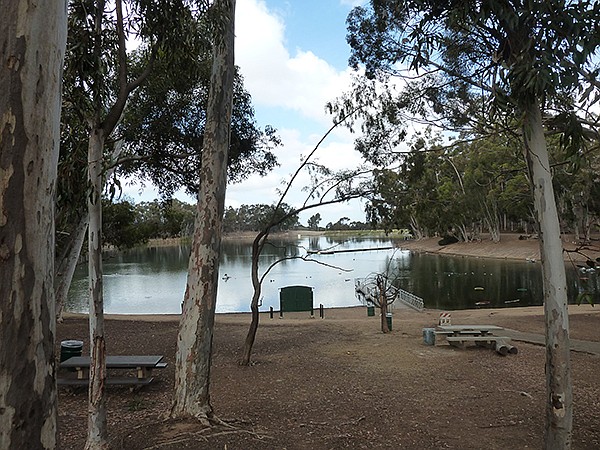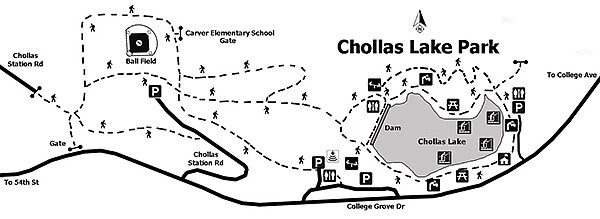 Facebook
Facebook
 X
X
 Instagram
Instagram
 TikTok
TikTok
 Youtube
Youtube

Named for the cholla cactus found in the area, Chollas Lake Reservoir was built in 1901 to serve San Diego’s water supply. The 16-acre lake was turned over to the city’s Department of Park and Recreation for management in 1966 and in 1971 was designated a youth fishing lake. Many recreational activities are within the 60-acre preserve. All this is within easy freeway accessibility in the heart of a relatively densely built-out urban/suburban area.

From the main entrance parking lot, the first visitor impressions will be of the lake, its many water-loving birds, and a surrounding forest of towering eucalyptus. These trees are spaced for easy child exploration and have the significant advantage of providing abundant shade on a warm summer day while still allowing nearly unimpeded views of the lake from nearly all places. Around the lake is a 0.8 mile dirt path where dragonflies and damselflies can be seen at the water’s edge. Dragonflies used to be called “devil’s darning needles.” Stories say they could sew up the lips of lying children. They have strong, rapid and deliberate flight, and cannot fold their wings when still. They hunt the muddy edges of lakes and ponds, holding their legs like baskets to capture smaller flying insects and dash them into the water. Damselflies are slender and more delicate than dragonflies, having a weaker, slower, and more fluttering flight, and while at rest they angle their wings back toward their abdomen. They can be found on stems of plants that grow near ponds.
North of the lake loop is a designated “nature” trail that meanders along a hillside filled with more eucalyptus, plus an assortment of native and non-native plants and a small garden of mixed, mostly nonnative succulents that include species of agave and yucca, aloes, and some cacti.

At the western end of the lake the more adventuresome can descend a hill and exit a back gate for a longer walk in the park. The eastern section of the park consists of several trails that can be combined into a variety of lengths ranging from a simple in-and-out mile-long walk to routes that could exceed three miles. The most straightforward route has very little elevation gain/loss, but other routes might total a few hundred feet.
This western area or the park has obviously seen considerable human influence and is now awash in disturbed soils that provide a great breeding ground for nonnative mustards, crown daisies, European grasses, and escaped landscape plants such as Brazilian and Peruvian pepper trees, Cyclops acacia, Perez’s sea lavender, and jade plant. However, there are also our usual native representatives such as laurel sumac, lemonade berry, black willow, cottonwood, sycamore, elderberry, buckwheat, tarweed, broom baccharis, and California sagebrush. While there is considerable plant life to observe, the biodiversity is not high. Those interested in an unspoiled environment with more species variation are advised to seek out other areas.
The major wildlife attraction is undoubtedly the birds at the lake. There are the usual urban denizens: pigeons, sparrows, doves, seagulls, ravens, and grackles; but, there is also a large collection of “lake birds,” including mallards, coots, grebe, egret, scaups, Muscovy ducks, and several types of geese (gray, snow, and various domestic Chinese and African).
Distance from downtown San Diego: About 10 miles. Allow 20 minutes driving time (College Grove). Take SR-94 E and exit on Broadway/College Ave. Turn right (northwest) on College Ave. and then left (southwest) on College Grove Dr. The main entrance to the park is on the right at 6350 College Grove Dr., just past College Grove Way. There are three parking lots with two farther west of the main entrance.

Hiking length: Variable from under 1 mile to over 3 miles, depending on how many trails are chosen — loop trails of 0.8 mile, 1 mile, and 1.4 miles, and some in-and-out shorter trails.
Difficulty: Easy. Elevation gain/loss depends on the trail selected — varies from no gain/loss to up to 200 feet on pavement or dirt. Open 6:30 a.m. to sunset, closed on some holidays. Facilities and water. Bikes and dogs (on leashes) allowed. Free fishing for ages 15 and under. For more information call 619-527-7683.


Named for the cholla cactus found in the area, Chollas Lake Reservoir was built in 1901 to serve San Diego’s water supply. The 16-acre lake was turned over to the city’s Department of Park and Recreation for management in 1966 and in 1971 was designated a youth fishing lake. Many recreational activities are within the 60-acre preserve. All this is within easy freeway accessibility in the heart of a relatively densely built-out urban/suburban area.

From the main entrance parking lot, the first visitor impressions will be of the lake, its many water-loving birds, and a surrounding forest of towering eucalyptus. These trees are spaced for easy child exploration and have the significant advantage of providing abundant shade on a warm summer day while still allowing nearly unimpeded views of the lake from nearly all places. Around the lake is a 0.8 mile dirt path where dragonflies and damselflies can be seen at the water’s edge. Dragonflies used to be called “devil’s darning needles.” Stories say they could sew up the lips of lying children. They have strong, rapid and deliberate flight, and cannot fold their wings when still. They hunt the muddy edges of lakes and ponds, holding their legs like baskets to capture smaller flying insects and dash them into the water. Damselflies are slender and more delicate than dragonflies, having a weaker, slower, and more fluttering flight, and while at rest they angle their wings back toward their abdomen. They can be found on stems of plants that grow near ponds.
North of the lake loop is a designated “nature” trail that meanders along a hillside filled with more eucalyptus, plus an assortment of native and non-native plants and a small garden of mixed, mostly nonnative succulents that include species of agave and yucca, aloes, and some cacti.

At the western end of the lake the more adventuresome can descend a hill and exit a back gate for a longer walk in the park. The eastern section of the park consists of several trails that can be combined into a variety of lengths ranging from a simple in-and-out mile-long walk to routes that could exceed three miles. The most straightforward route has very little elevation gain/loss, but other routes might total a few hundred feet.
This western area or the park has obviously seen considerable human influence and is now awash in disturbed soils that provide a great breeding ground for nonnative mustards, crown daisies, European grasses, and escaped landscape plants such as Brazilian and Peruvian pepper trees, Cyclops acacia, Perez’s sea lavender, and jade plant. However, there are also our usual native representatives such as laurel sumac, lemonade berry, black willow, cottonwood, sycamore, elderberry, buckwheat, tarweed, broom baccharis, and California sagebrush. While there is considerable plant life to observe, the biodiversity is not high. Those interested in an unspoiled environment with more species variation are advised to seek out other areas.
The major wildlife attraction is undoubtedly the birds at the lake. There are the usual urban denizens: pigeons, sparrows, doves, seagulls, ravens, and grackles; but, there is also a large collection of “lake birds,” including mallards, coots, grebe, egret, scaups, Muscovy ducks, and several types of geese (gray, snow, and various domestic Chinese and African).
Distance from downtown San Diego: About 10 miles. Allow 20 minutes driving time (College Grove). Take SR-94 E and exit on Broadway/College Ave. Turn right (northwest) on College Ave. and then left (southwest) on College Grove Dr. The main entrance to the park is on the right at 6350 College Grove Dr., just past College Grove Way. There are three parking lots with two farther west of the main entrance.

Hiking length: Variable from under 1 mile to over 3 miles, depending on how many trails are chosen — loop trails of 0.8 mile, 1 mile, and 1.4 miles, and some in-and-out shorter trails.
Difficulty: Easy. Elevation gain/loss depends on the trail selected — varies from no gain/loss to up to 200 feet on pavement or dirt. Open 6:30 a.m. to sunset, closed on some holidays. Facilities and water. Bikes and dogs (on leashes) allowed. Free fishing for ages 15 and under. For more information call 619-527-7683.
Comments